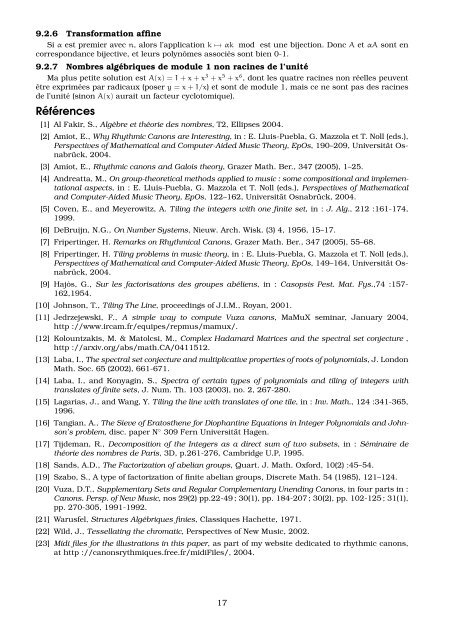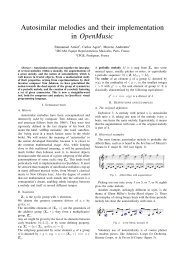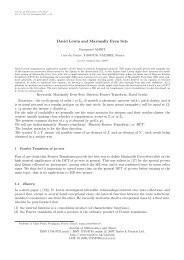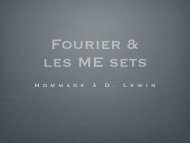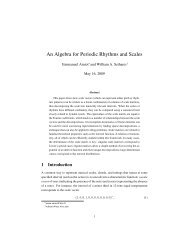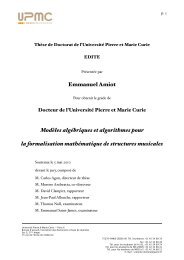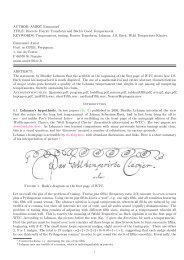`A propos des canons rythmiques - Free
`A propos des canons rythmiques - Free
`A propos des canons rythmiques - Free
You also want an ePaper? Increase the reach of your titles
YUMPU automatically turns print PDFs into web optimized ePapers that Google loves.
9.2.6 Transformation affineSi α est premier avec n, alors l’application k ↦→ αk mod est une bijection. Donc A et αA sont encorrespondance bijective, et leurs polynômes associés sont bien 0-1.9.2.7 Nombres algébriques de module 1 non racines de l’unitéMa plus petite solution est A(x) = 1 + x + x 3 + x 5 + x 6 , dont les quatre racines non réelles peuventêtre exprimées par radicaux (poser y = x + 1/x) et sont de module 1, mais ce ne sont pas <strong>des</strong> racinesde l’unité (sinon A(x) aurait un facteur cyclotomique).Références[1] Al Fakir, S., Algèbre et théorie <strong>des</strong> nombres, T2, Ellipses 2004.[2] Amiot, E., Why Rhythmic Canons are Interesting, in : E. Lluis-Puebla, G. Mazzola et T. Noll (eds.),Perspectives of Mathematical and Computer-Aided Music Theory, EpOs, 190–209, Universität Osnabrück,2004.[3] Amiot, E., Rhythmic <strong>canons</strong> and Galois theory, Grazer Math. Ber., 347 (2005), 1–25.[4] Andreatta, M., On group-theoretical methods applied to music : some compositional and implementationalaspects, in : E. Lluis-Puebla, G. Mazzola et T. Noll (eds.), Perspectives of Mathematicaland Computer-Aided Music Theory, EpOs, 122–162, Universität Osnabrück, 2004.[5] Coven, E., and Meyerowitz, A. Tiling the integers with one finite set, in : J. Alg., 212 :161-174,1999.[6] DeBruijn, N.G., On Number Systems, Nieuw. Arch. Wisk. (3) 4, 1956, 15–17.[7] Fripertinger, H. Remarks on Rhythmical Canons, Grazer Math. Ber., 347 (2005), 55–68.[8] Fripertinger, H. Tiling problems in music theory, in : E. Lluis-Puebla, G. Mazzola et T. Noll (eds.),Perspectives of Mathematical and Computer-Aided Music Theory, EpOs, 149–164, Universität Osnabrück,2004.[9] Hajòs, G., Sur les factorisations <strong>des</strong> groupes abéliens, in : Casopsis Pest. Mat. Fys.,74 :157-162,1954.[10] Johnson, T., Tiling The Line, proceedings of J.I.M., Royan, 2001.[11] Jedrzejewski, F., A simple way to compute Vuza <strong>canons</strong>, MaMuX seminar, January 2004,http ://www.ircam.fr/equipes/repmus/mamux/.[12] Kolountzakis, M. & Matolcsi, M., Complex Hadamard Matrices and the spectral set conjecture ,http ://arxiv.org/abs/math.CA/0411512.[13] Laba, I., The spectral set conjecture and multiplicative properties of roots of polynomials, J. LondonMath. Soc. 65 (2002), 661-671.[14] Laba, I., and Konyagin, S., Spectra of certain types of polynomials and tiling of integers withtranslates of finite sets, J. Num. Th. 103 (2003), no. 2, 267-280.[15] Lagarias, J., and Wang, Y. Tiling the line with translates of one tile, in : Inv. Math., 124 :341-365,1996.[16] Tangian, A., The Sieve of Eratosthene for Diophantine Equations in Integer Polynomials and Johnson’sproblem, disc. paper N ◦ 309 Fern Universität Hagen.[17] Tijdeman, R., Decomposition of the Integers as a direct sum of two subsets, in : Séminaire dethéorie <strong>des</strong> nombres de Paris, 3D, p.261-276, Cambridge U.P, 1995.[18] Sands, A.D., The Factorization of abelian groups, Quart. J. Math. Oxford, 10(2) :45–54.[19] Szabo, S., A type of factorization of finite abelian groups, Discrete Math. 54 (1985), 121–124.[20] Vuza, D.T., Supplementary Sets and Regular Complementary Unending Canons, in four parts in :Canons. Persp. of New Music, nos 29(2) pp.22-49 ; 30(1), pp. 184-207 ; 30(2), pp. 102-125 ; 31(1),pp. 270-305, 1991-1992.[21] Warusfel, Structures Algébriques finies, Classiques Hachette, 1971.[22] Wild, J., Tessellating the chromatic, Perspectives of New Music, 2002.[23] Midi files for the illustrations in this paper, as part of my website dedicated to rhythmic <strong>canons</strong>,at http ://<strong>canons</strong><strong>rythmiques</strong>.free.fr/midiFiles/, 2004.17


